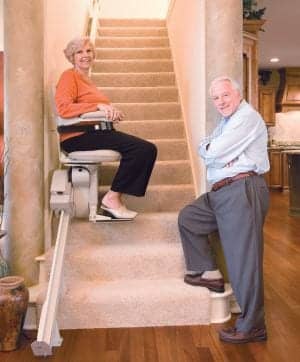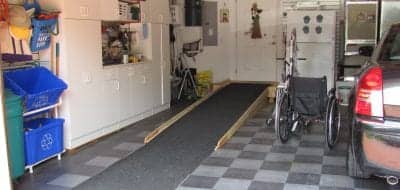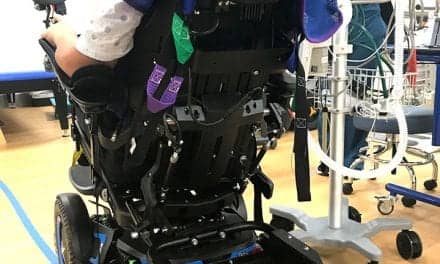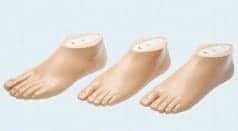
Indoor stair lifts are one of the modification options that can help create a barrier-free environment in multi-level homes and townhouses.
With the number of individuals with disabilities growing, and ranks of aging baby boomers on the rise, there has been a heightened awareness of home accessibility needs and aging-in-place services. It is estimated that approximately 15.1% of Americans (41.3 million) will have at least one type of disability, and within that group half (22.7 million) will have two or more types of disabilities.1 Over the last 10 years, I have witnessed a shift in our healthcare system, including shorter inpatient rehab stays, a rise in home health care needs, and growth in the number of assisted living facilities. While working in the community, I have witnessed that, more often than not, these trends in healthcare create more specialized service needs in the home.
The home modification service delivery model uses a team approach that spreads across both healthcare and housing sectors. This team usually includes the individual (home dweller), caregivers, construction and building professionals, healthcare professionals who are often occupational therapists, referring agencies, and funding sources. My perspective as a community-based occupational therapist and wheelchair mobility-seating specialist includes individual needs beyond the wheelchair. When measuring an individual for a wheelchair, the home environment is also measured and included in the assessment prior to making the final recommendations. This also includes assessing caregiver needs and other types of durable medical equipment and assistive technologies used in the home.
THE HOME ASSESSMENT: MEASURING BOTH THE PERSON AND THE ENVIRONMENT
Most clinicians are familiar with the Americans with Disabilities Act (ADA). The US Department of Justice adopted the revised ADA standards in September 2010, which will become mandatory in March 2012. These guidelines are in place to ensure accessibility to places of public accommodation and commercial facilities by individuals with disabilities. However, ADA requirements do not extend into the home environment, and are not standards that can be enforced by code specifically for ADA. The Accessibility Guidelines for Buildings and Facilities (ADAAG) covers the construction and alteration of both private and public sector facilities. These are applied during the design, construction, and alteration of buildings and facilities covered by titles II and III of the ADA. While these standards are used as a guideline for measuring the home environment, measuring the individual and their abilities in their wheelchair within the home will maximize independence, health, and well-being.
Universal design (UD) should be understood prior to completing a home modifications assessment. Universal design is used to describe an environment that can be used by individuals with or without a disability, and pays particular attention to aesthetics When making home modification recommendations, it is important to consider the individual’s life roles, social activities, and cultural influences, as well as consideration for other persons who reside in the home. Individuals will not want their home to look “institutionalized” or “handicapped,” and therefore being mindful of universal design is important.
RAMPS AND LIFTS
Ramps are the most familiar and common home accessibility modification. They can benefit those who use wheelchairs, walkers, and canes, or those who cannot safely climb stairs due to balance or strength impairments. Ramps can be constructed from wood, concrete, steel, or aluminum. ADA design standards call for a maximum ramp slope of 1:12. You will need 12 inches of ramp for every 1 inch of rise. Some individuals may find it difficult to propel a manual wheelchair up this amount of slope. For this reason, a slope of 1:16 to 1:20 is recommended where possible. Those who are dependent on power mobility should have little to no difficulty using a ramp slope of 1:12. However, those who use alternative drive controls (ie., head array or chin control) to operate their power wheelchairs may be more safe with a ramp slope of 1:16. When it comes to ramps, assessing an individual’s wheelchair skills is a critical part of choosing a ramp design.

Ramp installed inside the garage.
Some ramps may be more suitable inside the garage and allow for a more weather-controlled environment. Weather conditions and maintenance need to be considered for ramps outside the home. For example in Florida, homes that have a lot of canopy trees will cause slippery mold to grow on wood ramps over time due to the humid and warm weather conditions. Therefore, individuals who cannot maintain a ramp may be faced with safety hazards. Vertical lifts are also an option, but can be more costly than a ramp in some situations. However, when space is limited, vertical lifts offer a suitable option. A lot of home owners do not want a large and unattractive ramp or lift in the front view of their home. It is important to assess all the exterior doors of the home to give individuals options for an accessible entryway that is appealing and blends into the design of the home.
DOORWAYS
The ADA standards indicate that the minimum clear width of doorways should be 32 inches for individuals who use wheelchairs. Clear width means the actual user space available. Measuring just the door frames and not taking into account the door itself is a common mistake. Doors with standard hinges take up approximately one and one-quarter inches to one and one-half inches of clear width. For example, a door may measure 32 inches, but the door and door stops themselves can decrease the actual clear width. A standard 18-inch-wide manual wheelchair with handrims is approximately 26 inches to 27 inches wide. Swing clear hinges can be installed to give approximately 31 inches to 32 inches of clear width (including door stops) and give the end user plenty of room for hand propulsion without risk of skin tears or injuries. If a full 32 inches of clear width is needed, the contractor will need to install wider doors.
BATHROOMS AND KITCHENS
Bathroom modifications can be costly if not done correctly the first time. Too often, I have seen walk-in showers installed mistakenly when a roll-in shower was necessary to maximize independence. Before making modification recommendations, it is important to assess the individual’s physical abilities, strength, functional reach, transfer abilities, bathing and toileting equipment, and caregiver needs. Measurements taken of the individual help determine optimal heights for sinks and countertops, toilets, shower seats and grab bar placement, as well as type of hand-held shower head. According to ADA standards, grab bars should be installed in a horizontal position around a toilet 33 inches to 36 inches above the finished floor. However, persons who are taller than 6 feet may require grab bar heights outside these standards. Grab bar placement in showers and around toilets can be very individualized depending on the person’s height, transfer abilities, and functional reach range.

Therapist Cindi Petito, OTR/L, ATP, CAPS, and Scott Ross, CAPS, with Home Sweet Accessible Home review plans for a shower modification.
Another common mistake in home modification for all types of wheeled (or roll-in) shower devices occurs with the installation of prefabricated roll-in showers. ADA guidelines state that a change in floor level should be no more than one-quarter inch with vertical edges and one-half inch with beveled edges for wheelchair use. When prefabricated roll-in showers are installed, often they are installed on top of existing flooring. This creates a change in level greater than one-half inch. Once a collapsible water dam is installed on the outer edge of the shower floor, the amount of rise can be as high as one and one-fourth inches with the water dam collapsed. When an individual attempts to negotiate this type of roll-in shower in a self-propelling shower chair, they will encounter difficulty propelling the wheels up into the shower. Caregivers will also have difficulty pushing an occupied rolling shower chair into a prefabricated system such as this. Recessed and level roll-in showers with barrier-free water dams made of durable and collapsible soft vinyl allow for shower chairs to roll in easily.
Sink and countertop heights can vary depending on the individual’s height. With a person who is taller than 6 feet and wheelchair bound, long lower leg lengths and seat depths (buttock to knee) greater than 18 inches may require higher and deeper knee clearances. Measuring the person is especially important for those who use power wheelchairs because the minimum footplate ground clearance is 3 inches. The wheelchair’s overall floor-to-seat height with the seat cushion and thigh height measurement will tell you the knee height clearances needed not only in the bathroom and kitchen, but anywhere in the home where counters, desktops and tables are utilized. Another important consideration should be made for a person who uses either a manual or power wheelchair that has an actual seat depth of 20 inches and an overall user depth of 24 inches or more. For these individuals, commercial wall mounted sinks measuring 18 inches deep will be too short for adequate front reach and not allow enough depth underneath the sink for leg and foot placement.
Toilet access in small bathrooms can be challenging for persons who are wheelchair dependent. Once a doorway is widened to allow the appropriate clear width, maneuverable floor space may still be much smaller than the 5 foot x 5 foot turning radius. In these situations, selecting a toilet design that is more compact and includes a more narrow tank can increase user space by as much as one-half foot.
Kitchen modifications for individuals who are wheelchair bound include, but are not limited to, ensuring there is a 5 foot x 5 foot turning radius, installing functional height cabinets and creating knee space beneath countertops, and providing a recess near the baseboards for toes and kick plates. A 5 foot x 5 foot turning radius is the standard required by the ADA to make a 180-degree or a T-shaped turn in a wheelchair. Those who cannot afford new cabinets for knee space can remove cabinet doors below the sink and cupboards as an inexpensive alternative. Smaller appliances, such as microwaves, toasters and small convection ovens, steamers, and stovetop grills, may be the primary source for cooking meals when larger appliances cannot be used due to limited reach and knee space. For larger cooking appliances, a cooktop range set into the counter that leaves sufficient knee space below is an optimal solution for those who are wheelchair dependent.
STAIR LIFTS AND ELEVATORS
Indoor stair lifts and incline wheelchair lifts are an affordable option for multi-level homes and town houses. Elevators are expensive and most individuals cannot afford the cost. When recommending a stair lift for someone who uses a mobility device, assessing a person’s transfer skills, physical abilities, and use of a second mobility device is necessary. For persons who cannot safely transfer and maintain adequate sitting balance in a stair lift seat, incline wheelchair lifts are the most appropriate. Universal design is taken into consideration by ensuring others who reside in the home can also use the stairs safely. A minimum stairway width to accommodate a stair lift on a straight stairway is 36 inches. The stairway width requirements for incline wheelchair lifts will depend on the platform size needed to accommodate the wheelchair.
Funding home modifications can be challenging, but resources to help defray the costs are available. Working with professionals who are client-centered and part of a collaborative team will assist individuals in finding affordable methods for home modifications and creating a barrier-free environment.
Cindi Petito, OTR/L, ATP, CAPS, owner of Seating Solutions Inc, has been a private practitioner for 12 years, specializing in the area of mobility and complex rehab seating and home modifications for adults with neurological injuries and diseases. She can be reached at .
REFERENCE
- Brault M. Disability Status and the Characteristics of People in Group Quarters: A Brief Analysis of Disability Prevalence Among the Civilian Noninstitutionalized and Total Populations in the American Community Survey. 2008. [removed]www.census.gov/hhes/www/disability/GQdisability.pdf[/removed]





